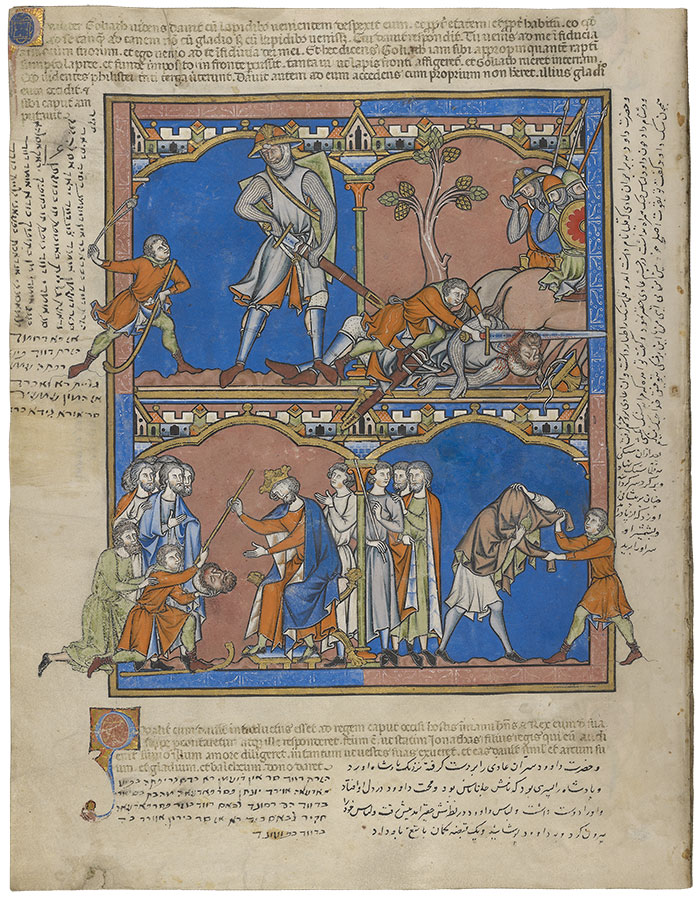
David Slays Goliath, David's Vow to Saul Fulfilled
Old Testament Miniatures with Latin, Persian, and Judeo-Persian inscriptions
Purchased by J.P. Morgan (1867–1943) in 1916
David Slays Goliath
Before Goliath can draw his sword, David strikes him in the forehead with a stone from his sling. As the dismayed Philistines look on, the victorious youth cuts off Goliath's head using the giant's own mighty sword. (1 Kings 17:45–51)
David's Vow to Saul Fulfilled
After David's victory over Goliath, Abner, commander of the army, presents the young hero to a grateful Saul. The king accepts the head of Goliath as proof of David's conquest and, as a token of friendship, David accepts the costly garments of the king's son, Jonathan. (1 Kings 17:57–1 Kings 18:4)
Folio 28v (Latin)
Upper half: How Goliath, upon seeing David coming with stones, reproached him for his age and appearance and because he had come to him as one would come to a dog, with stones instead of with a sword. Yet, David answers him saying: ’ you come to me trusting your arms, but I come to you trusting my God.’ As he was saying this, he hastily took a stone, placed it in his sling and smote Goliath, who was drawing near to meet him, in his forehead with so much force, that the stone was affixed to Goliath’s forehead and he sank to the ground. Seeing this, the terrified Philistines turned their backs and fled. David, on the other hand, approached Goliath and, as he did not have a sword of his own, killed him with his sword and cut off his head. (I Samuel 17: 41–51)
Lower half: How, when David had been brought before the king, with the head of Goliath in his hand, and the king asked him about his family and he answered, it came to pass that once he had heard David, Jonathan, the king’s son, at once fell in love with him, and loved him so deeply that he took off his clothes and gave them to him as a present together with his bow and his sword and his girdle. (I Samuel 18: 1–4)
Folio 28v (Persian)
Persian foliation: 16
Upper right margin: And His Excellence David came before that fierce one whose name was Qolia [Goliath] and [as] he was raising the sling the fierce man became furious and cursed him. Since David had no armor, he appeared small in the eye of the giant who said, "You have come to slay me like a dog!" David said, "You come to me with your innate power; I, with this nakedness, will fight with God’s help." After that, he placed a stone in the sling and swung it around his head and hurled it at his forehead so that he fell over and with his sword [David] severed his head.
Lower right: His Excellence David held the fierce man’s head in hand and brought it before the king. And the king had a son named Janatas [Jonathan] who had become fond of David and loved him. David’s garment appeared humble in his eyes; he went forth and removed his own clothes and put them on David and he [also] gave him a bow and a sword.
Folio 28v (Judeo-Persian)
Upper left margin: His Excellence David came up against this enemy; he appeared very contemptible in the eyes of the enemy since David had no accouterments of weapons. Goliath said to him, "Did you come to kill a dog?" David said, "You came into battle by the grace of accouterments of weapons, I [come] by the grace of God." David hurled a stone with the sling at Goliath’s forehead. He fell down, his Excellence David went forward, removed Goliath’s sword, and cut off his head with that same sword.
Lower right, beneath Latin: His Excellence David took the head of that enemy into his hand[s] and brought it before the king. And Jonathan, the king’s son, felt a great love for David, and [since] David’s clothes appeared [exceedingly] humble to the king’s son, he removed his own clothes so that he may put them on David.
Content consultant: Richard Leson
Persian translated by Sussan Babaie
Judeo-Persian translated by Vera Basch Moreen
Latin translation by Eran Lupu
After the commentary volume accompanying the Fine Art Facsimile edition by Faksimile Verlag Luzern
